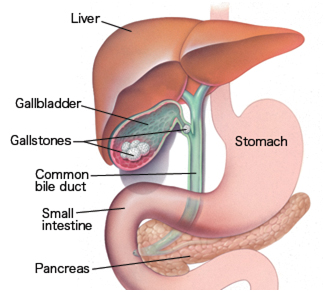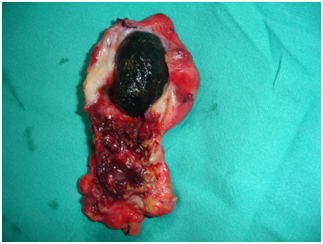MBBS,MS,FIAGES,FMAS, FMBS
Senior Consultant Surgeon
Minimal Access, ColoRectal, Gastrointestinal & Bariatric Surgery
 Gall Bladder is a small pear shaped organ located below the liver on the right side of the abdomen.
Gall Bladder is a small pear shaped organ located below the liver on the right side of the abdomen.
Function of Gall Bladder : It stores and concentrates bile produced by liver and releases it into the small intestine on eating fatty food.
Why do gall stones form? Gall stones form due to imbalance in the bile salts, cholesterol and water resulting in sediment formation and subsequently stone formation.
Some people are more prone to gall stone formation----
1) Women are 4 times more prone then males
2) Women who have had pregnancy , are overweight ,are on contraceptive pills
3) Excess fat in diet is a risk factor
4) Fasting for long hours
5) Typhoid Fever
Gall stones can develop at any age ( from child to elderly)
Signs and symptoms of Gall stones-
Stones in gall bladder—It may be silent or may cause pain (mainly in right upper abdomen) associated with nausea , vomiting, bloating, heartburn, fever.
Stones in cystic duct--- Stone can enter the cystic duct leading to retention of fluid inside the gall bladder resulting in distention of the gall bladder, infection in the gall bladder ( Acute cholecystitis) or pus formation in the gall bladder (Empyema).
Stones in common bile duct (CBD)--- Stone can slip from the gall bladder into the CBD resulting in the blockage of the bile flow from liver to intestine leading to development of jaundice(yellow discolouration of skin , eyes and urine)—It is called obstructive jaundice. This also leads to fever, central abdominal pain, vomiting, and anorexia.
This at times may result in pancreatitis which may prove fatal.
Diagnosis and evaluation of the patient---
- Ultrasound abdomen (investigation of choice)-it is able to show stones in 98% cases.
- MRCP/ CT scan abdomen---may be required in complicated cases
- ERCP---required in suspected cases of CBD stone
- LFT (Liver function test)—to rule out possibility od CBD stone
- CBC, Blood Sugar, Blood urea, urine R/M, X-ray Chest and ECG to evaluate general well being of the patient to tolerate surgery
Treatment
Stones in gall bladder--- Laparoscopic Cholecystectomy
Stones in cystic duct--- Laparoscopic Cholecystectomy
Stones in common bile duct (CBD) --- Endoscopic removal of CBD stone followed by Laparoscopic Cholecystectomy
Why Cholecystectomy ( Removal of Gall Bladder) ?
- Internationally, it is the only accepted treatment option for gall stones.
- Once gall stones form, gall bladder is already diseased, has reduced capacity and is non functioning.
- Risk of cancer formation in this diseased gall bladder. Gall bladder cancer is very difficult to diagnose, is easily missed on routine investigation, very difficult to treat on routine investigations, and has high mortality rate.
- If only gall stone is removed there is risk of recurrence which is eliminated if gall bladder is removed
- High risk of complications of gall stones—Infection, Empyema, perforation of gallbladder, CBD stone to name a few.
- In my experience, medicines used by few of my patients to treat stones lead to more complications such as slipping of stones in CBD .
Why Laparoscopic Cholecystectomy ?
 Laparoscopic Cholecystectomy (or lap chole as it is generally termed) is performed by skilled surgeon who has required training and adequate experience to deal with such cases.
Laparoscopic Cholecystectomy (or lap chole as it is generally termed) is performed by skilled surgeon who has required training and adequate experience to deal with such cases.
3-4 small incisions are given in the abdomen to introduce our sleek instruments to perform the surgery while watching on the monitor.
If at some stage during the operation we find that it will not be safe for the patient to undergo lap chole than we convert it into open procedure.
WE WANT YOU SAFE
Chances to conversion to open procedure increases in patients with empyema, acute attack, perforation , dense adhesions, pancreatitis etc.
Advantages of lap chole
- Early discharge and Early return to Normal life
- Early food intake
- Less postoperative pain
- Cosmetically placed scars
- Less work time lost and hence less financial loss
- Economically cheaper
- IT IS NOW A GOLD STANDARD TREATMENT FOR GALL STONES
Preoperative instructions
- Get all preoperative investigations
- Regular medication to continue for BP, Diabetes, Thyroid, Heart ailment
- Stop blood thinning medication such as aspirin, clopedogril etc atleast 3 days prior to surgery
- Take morning doses of medication on the day of surgery (with only a sip of water) except for diabetes . However confirm it with your doctor.
- Take light diet a day before surgery and DO NOT TAKE ANYTHING ORALLY AFTER 10 PM till surgery
- REACH HOSPITAL ON TIME TO REDUCE LAST MINUTE ANXIETY AND DELAYS-----IT IS IN YOUR OWN BENEFIT
- CARRY ALL THE NECESSARY DOCUMENTS INCLUDING INVESTIGATIONS.
Postoperative instructions
- Avoid fatty ,oily and spicy food for 2 weeks
- Take your medication as prescribed
- Can do light physical activity which can be gradually increased over 2 weeks to normal activity
- Visit the doctor as adviced
- Take preoperative medication for BP, Diabetes, Thyroid, heart as already taking
- Collect your gall bladder HPE report
- FEEL FREE TO TALK TO YOUR DOCTOR IN CASE YOU HAVE SOME PROBLEM.
| Home | About us | Services | Gallery | Testimonial | International Patients | Contact us | © Copyright Reserved to Dr. Saket Goel |
